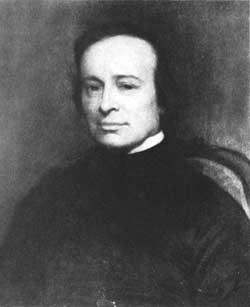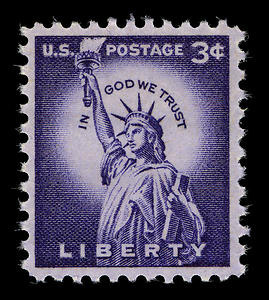 Three Statues of Liberty
Three Statues of Liberty
- There is the most famous one at the entrance to the New York harbor positioned on Liberty Island.
- Another on the Swan Ally Island in Paris, France in the Seine River near the Grenelle Bridge.
- And the third statue is in Luxembourg Gardens, also in Paris. The statue in Luxembourg Gardens in the original life size cast.
An Idea Is Born
 Edouard de Laboulaye, who proposed that a memorial to American independence he built. |
AT A DINNER at the home of Edouard de Laboulaye, near Versailles, France, in the summer of 1865, was born the idea of presenting to the United States a monument commemorating the birth of that still-young nation and the friendship that had endured between it and France ever since the American Revolution. It was shortly after the close of the American Civil War and just after the assassination of President Lincoln—an event that had greatly affected France and particularly its simple people, who felt they had lost a living symbol of freedom. So deeply had the French masses been moved by the tragedy, that they got up a collection (the limit kept to 2 cents from any one donor, to maintain the character of the gift) and with it had designed a gold medal, which was sent to the widow of the murdered President with the message: “Tell Mrs. Lincoln that in this little box is the heart of France.” The medal bore, in French, the words:
Dedicated by French democracy to Lincoln, twice-elected President of the United States—honest Lincoln who abolished slavery, reestablished the union, and saved the Republic, without veiling the Statue of Liberty.
Throughout the Civil War, when imperial and official France—the France of the hereditary caste system—sought to aid the Confederacy, De Laboulaye, a historian, professor, and outstanding interpreter of the American Government, had been the liberal most worth listening to. In a review of a book by Agenor, Count Gasparin, who was an abolitionist on the grounds of Christian ethics, De Laboulaye has written:
Until a new sort of politics was lately found for us, it was accepted on both sides of the ocean as a virtual article of faith that America and France are sisters. . . . We claim that France never fights for an interest, only for an idea. I accept this proud device and ask: If we aid the South, what idea shall we be defending?
So it was fitting that the idea that resulted in the Statue of Liberty, now standing guard in New York Harbor, was the outgrowth of a discussion held at De Laboulaye’s dinner that summer evening in 1865. The guests were prominent, in letters, politics, and the arts. One of them was a young Alsatian sculptor, Frederic Auguste Bartholdi.
Translated, the Deed of Gift reads:
The Fourth of July, 1884, Anniversary Day of American Independence.
In presence of M. Jules Ferry, Minister of Foreign Affairs of France, and President of the Council of Ministers.
Count Ferdinand de Lesseps, in the name of the Committee of the Franco-American Union, and of the national manifestation of which that Committee has been the organ, has presented the colossal statue of “Liberty Enlightening the World,” the work of the sculptor Bartholdi, to His Excellency, Mr. Morton, United States Minister at Paris, praying him to be the interpreter of the national sentiment of which this work is the expression.
Mr. Morton, in the name of his compatriots, thanks the Franco-American Union for this testimony of sympathy from the French people; he declares that, in virtue of the powers conferred upon him by the President of the United States, and the Committee of Work in America, represented by its honorable president, Mr. William M. Evarts, he accepts the statue, and that it shall be erected in conformity with the vote of Congress of the 22nd of February, 1877; in the harbor of New York, as a souvenir of the unalterable friendship of the two nations.
In faith of which there have signed:
In the name of France:
Jules Ferry—Jules Brisson.In name of the Committee of the Franco-American Union:
Ferdinand de Lesseps—Edmond de Lafayette.In name of the United States:
Levi P. Morton.
Above is a reproduction of the proces-verbal, signed by those taking part in the presentation of the Statue of Liberty by France to the United States in Paris, July 4, 1884.
When the Statue of Liberty was shipped to the United States and erected on its pedestal at Bedloe’s Island, in 1886, photographs, which are now in the Library of Congress, of both Deed of Gift and the proces-verbal were sent with it. The originals are in the Paris Archives.

The Statue of Liberty Enlightening the World was dedicated October 28, 1886. Count de Lesseps and Senator Evarts were among the speakers. Bartholdi, in the torch some 300 feet above, pulled the rope that removed the French tricolor from Liberty’s face. Then, President Grover Cleveland accepted the statue on behalf of the United States. Especially impressive were these words of his: “We will not forget that Liberty has here made her home; nor shall her chosen altar be neglected.”
That night the torch held high in the hand of the statue was lighted.
Dimensions of the Statue
Feet Inches Height from base to torch 151 1 Foundation of pedestal to torch 305 1 Heel to top of head 111 1 Length of hand 16 5 Index finger 8 0 Circumference at second joint 3 6 Size of fingernail, 13 x 10 inches Head from chin to cranium 17 3 Head thickness from ear to ear 10 0 Distance across the eye 2 6 Length of nose 4 0 Right arm, length 42 0 Right arm, greatest thickness 12 0 Thickness of waist 35 0 Width of mouth 3 0 Tablet, length 23 7 Tablet, width 13 7 Tablet, thickness 2 0 Height of granite pedestal 89 0 Height of foundation 65 0 Weight of copper used in statue, 200,000 pounds (100 tons) Weight of steel used in statue, 250,000 pounds (125 tons) Total weight of statue, 450,000 pounds (225 tons) Copper sheeting of statue is 3/32-inch thick
 3 cent stamp
3 cent stamp
































